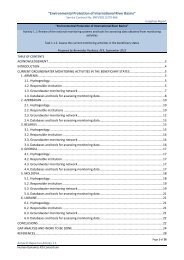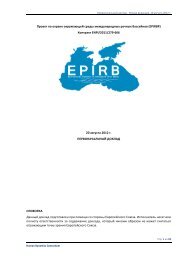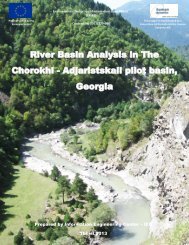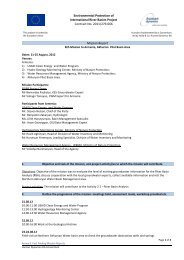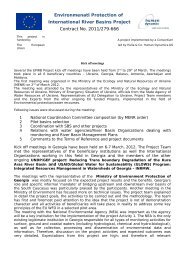Nokia Standard Document Template - Environmental Protection of ...
Nokia Standard Document Template - Environmental Protection of ...
Nokia Standard Document Template - Environmental Protection of ...
- No tags were found...
You also want an ePaper? Increase the reach of your titles
YUMPU automatically turns print PDFs into web optimized ePapers that Google loves.
5th Mission Report _KE3_March-April 2013i. The Temperature must be 20ºC, sometimes it was 18ºC, and therefore the analysis should bediscounted in such circumstances.ii. The Relative Humidity changed significantly on a daily basis owing to the sensor not set upcorrectly- this was easily rectified.3) The Carey portable spectrophotometer was faulty and no longer used for air and water analysis fornitrates, nitrites, & phosphates. The accreditation agency stated that they should have been informedabout the condition <strong>of</strong> this instrument and also informed that this analysis was no longer done. Thisproblem was also easily rectified.Analytical Quality ControlThe method validation s<strong>of</strong>tware submitted at the workshop initially functioned well but recently couldnot be operated. This is currently being investigated by their computer expert, Vova Linik, and the KE3submitted an expert link to resolve this problem.Since the last AQC training workshop, new staff had recently been engaged and the KE3 was requested tosubmit another customized workshop to concentrate on internal AQC charts and method validations.Since the last AQC training workshop, new staff had recently been engaged and the KE3 was requested tosubmit another customized workshop to concentrate on internal AQC charts and method validations. Thestaff from the State Hydrogeological Department and the State Ecological Inspectorate were also invitedto attend. The list <strong>of</strong> all the delegates and the agenda is detailed in Annex 2 & 3. It is recommended thattraining certificates are issued to these staff by the Project.Water & Sediment SamplingAn important aspect <strong>of</strong> monitoring for the WFD is sampling. Therefore the KE3 focused on the SamplingDepartment and submitted on-site training for the sampling staff at Westmurka Reservoir, near KishnerGate at the sampling platform on 10th April. The following issues were noted:i. The pesticide bottles were not ideal, as they had large mouth, with a screw top lid. Such bottlescould suffer from high evaporation losses <strong>of</strong> volatile components and also it was difficult to avoidair being trapped in bottle, which should not be permitted.ii.iii.iv.Three bottles used preservatives: e.g. Sodium Hydroxide (NaOH) for phenol analysis, Chlor<strong>of</strong>orm(CHCl3) for nutrients parameters, and Sulphuric Acid H2SO4 for petroleum products. It wasrecommended that with the last two sample bottles should be washed with the sample beforeadding the reagents on site.These three bottles were 1L amber glass bottles stored un-capped. It was recommended that infuture they are stored with their caps on to prevent dust contaminating them. Also the caps hadfragile cardboard inserts, which had been damaged by the corrosive preservatives. In fact many <strong>of</strong>these were so damaged that the actual tin plate lid was corroding. It was recommended that allthese caps are replaced by plastic caps or with new caps with Teflon inserts.Large 2L plastic sampling containers were used to take the other water samples. These were alsonot ideal, as it was impossible to prevent air being trapped in the vessel and thus contaminating thesample. It was recommended that alternative bottles are used.v. There were four sediment samplers, two were grabbers, which appear to function well. The othertwo were core samplers- one could be operated manually and the other one could be usedPage 5 <strong>of</strong> 23




